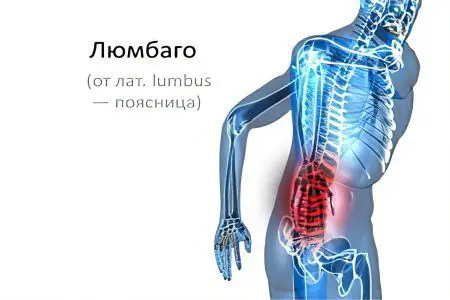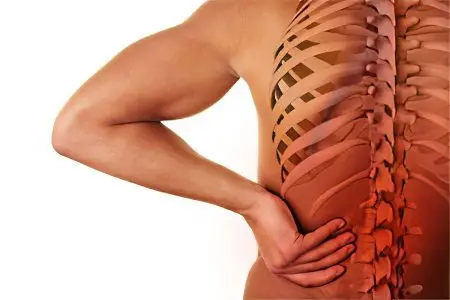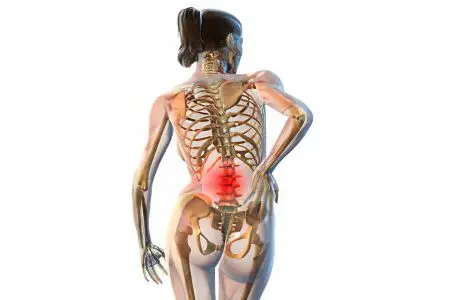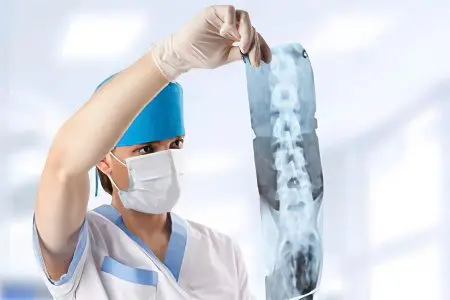Contents
If you overload your body with physical exercises, you can harm it. Often it is the spinal column in the lumbar that suffers. Lumbago is a sharp pain, which is the result of overexertion of the spine. Although other factors can cause lumbago, which everyone should know.
Lumbago – what is it?

Lumbago is not a pathology, but a symptom of a disorder. It is manifested by severe shooting pain in the spine. Lumbago is also called acute discogenic lumbalgia. With lumbago, the structures of the spine are destroyed. It is pain that indicates a developing disorder. Lumbago may first occur at a young age. Patients aged 25 years and older consult a doctor with complaints of back pain.
Acute pain in the spine should not be tolerated, since the lack of treatment will lead to chronicization of the pathological process. Pain will become a constant companion of a person, which will negatively affect the quality of his life. Therefore, when characteristic symptoms appear, it is necessary to consult a specialist.
Lumbago is characterized by increased pain during walking, bending over, coughing. As the pathology progresses, pain will spread to the buttocks and lower limbs. In the future, it will become difficult for a person to even simply give the body a straight position.
Lumbago is often confused with sciatica. There is such a kind of pathology as lumboischialgia. This disease is characterized by a combination of lumbago with sciatica. In this case, pain occurs due to deformation of muscles, ligaments and bone tissues.
What is the difference between lumbago and lumbodynia?
The main differences between lumbago and lumbalgia are presented in the table.
Lumbago | Lumbargia |
The pain is acute, unexpected for a person. Gains strength within minutes. | The pain worsens gradually over several days. |
The pain is acute, occurs immediately after the incident backache. | The maximum intensity of pain occurs in the morning hours. |
At rest, the pain goes away. | The pain becomes less severe when the person moves. |
The pain is aggravated by coughing and sneezing. | The pain is aggravated when a person stands or sits for a long time. |
The muscles are spasmodic, but not much. | Muscle spasm is very intense. |
The center of pain is in the lumbar region. | The pain radiates to the buttocks and thigh. |
People who lead an inactive lifestyle are susceptible to pathology. | People involved in sports and people who strain their lower back are more likely to suffer. |
In a few days the pain goes away. The attack lasts no more than 7 days. | The pain is chronic, if there is no treatment, then it will haunt a person on an ongoing basis. |
Causes of lumbago

Backache occurs due to the fact that the nerve fibers are intensely irritated. This applies to those nerves that are located in the fibrinous ring, in the ligaments surrounding it and in the vertebral bodies.
The main causes of lumbago:
Osteochondrosis.
Intervertebral hernia.
Overstrain of the muscles of the back in the lumbar region.
Displacement of the discs of the spinal column.
Vertebral tumor.
Congenital malformations of the spine with a decrease in the normal distance between the vertebrae.
The leading cause of lumbago is osteochondrosis. If it is complicated by a hernial protrusion, then the pain will intensify.
Internal causes of lumbago development

The internal causes of the development of lumbago include:
Displacement of the overlying vertebra in relation to the underlying one.
Kyphosis.
Stenosis.
Fibromyalgia.
Osteomyelitis.
Bechterew’s disease.
Chronic narrowing of the central spinal canal in the lumbar region.
Tumors of the liver and kidneys.
Infectious lesion of the spinal column.
Rheumatoid joint disease.
The effect of stress on the body.
Diseases affecting the nervous system.
Inflammation of the muscles in the lower body.
External causes
Lumbago can develop under the influence of external factors, including:
Physical overload.
Hypothermia or overheating of the body.
Being in a draft.
Long pastime in an uncomfortable position.
Colds.
Received back injuries.
Making sudden movements.
Sleeping in an uncomfortable or anatomically incorrect position.
Symptoms of lumbago

Lumbago occurs unexpectedly for a person. The pain is sharp, stabbing, like a lumbago, but sometimes it can be pulsating. It is so intense that it forces a person to leave everything and freeze in the original position. The attack lasts from 30 minutes to several hours. Then it decreases a little, but by night it is gaining strength again.
The main symptoms of lumbago:
Muscle spasm. It is concentrated in the lumbar region, but the pain forces the person to tighten the buttocks, lower back, and hips. They become dense to the touch, swell.
Decreased mobility. It is difficult for the patient to straighten or bend the body, change its position.
Lying position. If a person takes it, then the pain is easier to bear.
Numbness of the lower extremities. It develops due to muscle spasm, in which the blood supply to the legs worsens.
Other symptoms of lumbago include:
Increased general weakness.
Deterioration of the digestive processes.
Constipation.
Frequent urination.
Disorders in the work of the genital organs.
Lumbago disease: classification and stages of the disease

Depending on the duration of the attack, there are 3 forms of the disease:
Acute lumbago. The attack lasts about 4 weeks.
Subacute lumbago. The attack lasts no longer than 3 months.
Chronic lumbago. Pain haunts a person for more than 3 months.
This classification is used by doctors in medical institutions.
There are also 2 stages of lumbago:
Active stage. It is characterized by intense pain and corresponds to the acute period of the attack. Painful for a person are any, even the most insignificant movements.
passive stage. The pain in a person persists, but does not occur with such force and not as often as in the active stage. Physical stress on the body can provoke pain. Most often, people with the passive stage of lumbago do not go to the doctor.
Diagnosis of lumbago

To diagnose lumbago and find out the cause of the attack, you need to visit a neurologist. During the examination, the doctor will determine the degree of intensity of pain, its nature. He will assess the condition of the muscles of the lower back, as well as the range of motion that is available to the person.
After the examination, the doctor will give the patient a referral for urine and blood tests. This will determine the degree of intensity of the inflammatory process.
Other diagnostic measures include:
Radiography. The study allows assessing the degree of damage to the vertebrae, identifying their possible injury, tumor neoplasms and developmental anomalies. X-ray is informative in terms of detecting osteochondrosis and displacement of the vertebrae.
MRI. The study provides information about the state of the spinal cord and intervertebral discs.
CT This diagnostic procedure is more informative than radiography. Thanks to its implementation, it is possible to obtain a three-dimensional image of the spine, which will allow the doctor to detect even minor damage to the examined tissues.
Scintigraphy. During the procedure, an isotope is injected into the patient’s body, which accumulates in the vertebrae. After that, the doctor takes a series of pictures. All areas that have damage in the form of purulent cavities, tumor neoplasms, and inflammatory processes will be visible on them.
Treatment
The primary task of treating lumbago is to relieve an acute attack of pain. To do this, you will need to completely unload the lumbar spine. To reduce the intensity of the inflammatory process, to relieve spasm and pain, it is necessary to take NSAIDs, as well as smear the pain site with an anti-inflammatory ointment. The doctor must prescribe drugs.
In the case of very severe pain, which is difficult to remove even with injections, the patient is given a blockade. Novocaine or a hormonal drug is injected directly into the affected area. Only a trained doctor can engage in setting up a blockade. If the drug is administered incorrectly, then the person may remain disabled due to significant damage to the spine.
[Video] Dr. Evdokimenko – Acute lower back pain: how to treat. Disc herniation, lumbago, sciatica, sciatica:
Rehabilitation treatment after lumbago
After the therapy, the following recommendations should be followed:
Wear a corset that supports your lower back.
Allocate sufficient time for rest.
Be outdoors more often.
Take therapeutic baths.
Perform a back massage.
Sleep on your side. This will reduce the load on the spine.









